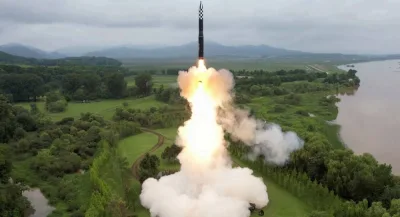South Korea’s Unification Ministry unveiled plans this week for individual tours in the North’s major tourist sites.
The effort is meant to appease Pyongyang, which has criticised the South for lacklustre progress after their leaders agreed to restart economic co-operation in 2018.
Tourism is not subject to international sanctions imposed over North Korea’s nuclear and missile programmes, and the proposals are designed to avoid breaching UN bans on bulk cash transfers and joint business ventures with North Korea.
Seoul says the United States knows of its plans, and South Korean officials are seeking to sound out Pyongyang about them, albeit quietly given the sensitivity of relations, officials said.
After Moon called for reopening North Korea tours in his New Year speech, Seoul diplomats led by nuclear envoy Lee Do-hoon visited Washington.
US officials, including Deputy Secretary of State Stephen Biegun, reacted well to the idea, a diplomatic source said.
“Biegun practically gave a blank cheque. But of course it doesn’t mean that they want to see a million dollars written down on it right away,” the source said, referring to sanctions concerns.
Officials and businessmen are concerned that the North will not welcome the offer.
In November, Pyongyang threatened to bulldoze “backward, shabby” South Korean tourist facilities at its Mount Kumgang resort.
At a key policymaking meeting last month, it vowed to overcome economic difficulties on its own through “an offensive for frontal breakthrough.”
“It would be a policy shift if the North accepts it,” a South Korean official said, referring to the tourism plan. “And frosty relations aside, they don’t really like South Koreans roaming through their country.”
Amid stalled nuclear talks with Washington, the North has effectively halted formal inter-Korean dialogue after three summits and a flurry of diplomacy in 2017-18, criticising what it calls the South’s US-reliant policy.
“I’m not sure if restarting tourism with the South is in line with their ‘frontal breakthrough’ campaign, but there can always be a surprise, and some of the plans such as invitation-based visits are already taking place on a limited scale,” said an official at a South Korean company previously involved in the initiative.
South Korean officials and those who are close to Moon have increasingly grumbled about Washington’s position that it will maintain sanctions until Pyongyang takes substantial steps toward denuclearisation.
Harry Harris, the US ambassador to South Korea, has recently become the face of that discontent after suggesting Seoul run its tourism idea through a joint working group.
Jeong Se-hyun, a former unification minister who advises Moon, even called for designating Harris as a “persona non grata.”
Kumgang tourism was a joint venture, now banned by sanctions, that provided a rare source of cash for Pyongyang worth millions of dollars a year.
The number of visitors peaked in 2007 to a total of some 350,000, with up to 2,000 crossing the border daily, the industry official said.
Seoul’s new proposal includes not only Kumgang but also new areas built up under Kim, including the Wonsan coastal tourist zone, the Samjiyon alpine town and Yangdok hot spring resort.



